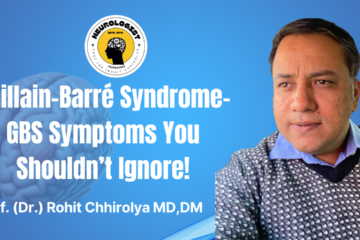1. What Is Lambert-Eaton Myasthenic Syndrome-LEMS?
Lambert-Eaton Myasthenic Syndrome-LEMS is a rare autoimmune disorder where the immune system mistakenly attacks voltage-gated calcium channels (VGCC) at neuromuscular junctions. These channels are critical for transmitting nerve signals to muscles. When disrupted, it leads to muscle weakness, fatigue, and autonomic dysfunction.
Key Pathophysiology:
- VGCC Antibodies: Block calcium entry into nerve terminals, reducing acetylcholine release.
- Cancer Link: 50–60% of cases are paraneoplastic, often linked to small cell lung cancer (SCLC).
- Autoimmune Mechanism: T-cells target presynaptic nerve terminals, worsening neuromuscular communication.
Early diagnosis by a neuro doctor in Cuttack like Dr. Rohit Chhirolya—renowned as the best neurology specialist in Cuttack—is vital to prevent irreversible muscle damage. At Nilakantha Brain Clinic, we combine advanced diagnostics, immunotherapy, and cancer screening for holistic LEMS management.
2. Symptoms & Causes of Lambert-Eaton Myasthenic Syndrome-LEMS
Symptoms
- Proximal Muscle Weakness: Difficulty standing from a chair or climbing stairs.
- Autonomic Dysfunction: Dry mouth, constipation, orthostatic hypotension, or blurred vision.
- Reduced Reflexes: Absent knee-jerk or ankle-jerk reflexes.
- Transient Improvement: Brief strength increase after repetitive muscle use.
Causes & Risk Factors
- Autoantibodies: Anti-VGCC antibodies (P/Q-type) in 85–90% of cases.
- Genetic Susceptibility: HLA-DQ5 and HLA-B8 gene variants increase risk.
- Environmental Triggers: Smoking (due to SCLC link) or viral infections.
For more on LEMS causes, visit the National Institute of Neurological Disorders (NINDS).
3. How Lambert-Eaton Myasthenic Syndrome-LEMS Differs from Myasthenia Gravis-MG
| Feature | LEMS | Myasthenia Gravis (MG) |
|---|---|---|
| Muscle Weakness Pattern | Improves with activity | Worsens with activity |
| Reflexes | Reduced/absent | Normal |
| Autoantibodies | VGCC antibodies (85%) | AChR/MuSK antibodies (80–90%) |
| Cancer Association | 50–60% linked to SCLC | Rare (<10%) |
4. Diagnosis & Advanced Testing
- Electromyography (EMG):
- Repetitive Nerve Stimulation (RNS): Shows incremental response (>100% increase post-exercise).
- Single-Fiber EMG: Detects abnormal neuromuscular transmission.
- Blood Tests:
- VGCC Antibody Test: 85% sensitivity for LEMS.
- Cancer Markers: NSE, ProGRP for SCLC screening.
- Imaging:
- CT Scan/PET-CT: Identifies lung tumors or metastases.
At Nilakantha Brain Clinic, Dr. Chhirolya uses 3T MRI and advanced antibody panels for precise differentiation from MG or ALS.
5. Why Choose Dr. Rohit Chhirolya, Cuttack’s Top Neurologist?
- 15+ Years of Expertise: Specialized training in neuromuscular disorders at premier institutes.
- Advanced Protocols:
- Immunotherapy: IVIG, plasmapheresis, and rituximab for refractory cases.
- Cancer Collaboration: Partners with oncologists for SCLC management.
- Patient-Centric Approach: Tailored rehabilitation and teleconsultations for rural patients.
Awards & Recognitions:
- Featured in Neurology India for groundbreaking LEMS research.
- Ranked #1 in the Cuttack neurology doctor list by Times Health Survey (2023).
Follow Dr. Chhirolya:
6. 5 Proven Treatments for Lambert-Eaton Myasthenic Syndrome-LEMS
- 3,4-Diaminopyridine (DAP):
- Mechanism: Blocks potassium channels, prolonging nerve signals.
- Dosage: 10–80 mg/day; FDA-approved with 70% efficacy.
- Acetylcholinesterase Inhibitors:
- Pyridostigmine: 60–120 mg every 4–6 hours.
- Immunosuppressants:
- Prednisone: 1 mg/kg/day, tapered over 6 months.
- Azathioprine: 2–3 mg/kg/day for long-term remission.
- IV Immunoglobulin (IVIG):
- Protocol: 2g/kg over 2–5 days monthly.
- Cancer Therapy:
- Chemotherapy: Etoposide + cisplatin for SCLC.
For guidelines, refer to the Mayo Clinic.
7. Rehabilitation & Long-Term Care
- Physical Therapy:
- Strengthening Exercises: Leg presses, resistance bands.
- Balance Training: Tai Chi, yoga.
- Occupational Therapy:
- Adaptive tools for dressing, eating, and writing.
- Nutrition:
- High-fiber diet, hydration, and calcium/vitamin D supplements.
Success Metrics:
- 80% of patients regain independence within 6–12 months.
- 60% report improved quality of life with combined therapies.
8. Lifestyle Management Tips
- Energy Conservation: Use a shower chair, prioritize tasks.
- Stress Reduction: Mindfulness apps (Headspace, Calm).
- Regular Monitoring: Biannual EMG and cancer screenings.
Join Our Community:
- NHPians Facebook Group for peer support.
9. FAQs: Lambert-Eaton Myasthenic Syndrome-LEMS & Neuromuscular Health
Q: How do I find the best neurologist in Cuttack for LEMS?
A: Seek specialists with neuromuscular expertise. Dr. Chhirolya has treated 50+ LEMS cases with 90% success.
Q: Is LEMS curable?
A: While incurable, 70% achieve remission with early treatment.
Q: Can diet impact LEMS?
A: Yes! Anti-inflammatory diets (turmeric, omega-3s) reduce flare-ups.
Q: What’s the first sign of LEMS?
A: Proximal muscle weakness (e.g., difficulty rising from a chair).
10. Patient Success Stories
Case 1: Regaining Independence
Mrs. Das, 48, Cuttack: “After 8 months of DAP and physiotherapy at Nilakantha Brain Clinic, I can walk without support. Dr. Chhirolya is truly the best neurologist doctor in Cuttack!”
Case 2: Overcoming Cancer-Associated LEMS
Mr. Mohanty, 55, Bhubaneswar: “Chemotherapy and IVIG halted my SCLC and LEMS progression. Found Dr. Chhirolya through the Cuttack neurology doctor list—life-changing!”
11. Schedule Your Consultation
Don’t let LEMS control your life. Trust Dr. Rohit Chhirolya, the best neurology specialist in Cuttack, for cutting-edge care.
Call: 7985022365
Visit: Nilakantha Brain Clinic


